112
Views & Citations10
Likes & Shares
The goal of ICT is to improve the social and economic standard of living of the population (Chung, Lee, Ham, & Koo, 2021) through digital technologies. ICT is used for the local economy, public services, and traffic regulation (Zhu, Yu, Wang, Ning, Tang, 2018). It aims to make almost all components of human life, such as infrastructure, management, transportation, health, education, economy, industry (Ahad, Paiva, Tripathi, Feroz, 2020) and, tourism of course (Habeeb, Weli, 2020) increasingly smart (Ismagilova, Hughes, Dwivedi, & Raman, 2019).
The impact of ICT on tourism is especially notable. ICT can provide services to travelers in all basic areas - accommodation, food, entertainment, activities, shopping, transportation (Chung, Lee, Ham, Koo, & 2021). Besides, there are many travel apps for smartphones - Tripadvisor, LonelyPlanet, Redigo, MAPS.ME, HERE WeGo, Google Maps, Booking, Airbnb, Aviasales. Some of them help build the route, while others enable booking tickets or hotels. Indonesian Smart Traveling app, for instance (Irmanti, Hidayat, Amalina, Suryani, 2017) allows one to find out interesting events taking place in a particular area, get information about the location of the police station or hospital, or even assist in object recognition, which can be used to get information about a specific landmark (Irmanti, Hidayat, Amalina, & Suryani, 2017).
In the meantime, a number of scholars argue that the implementation of smart technologies is not about the achievements alone but brings adverse outcomes as well. These include the relative availability of personal data, the problem of personal freedom due to systematic control, and income discrimination-the poor cannot fully benefit from ICT (Gandy, Nemorin, 2019; Pérez León, León Sánchez, & Guerrero, 2021). In view of this, it seems relevant to pay more attention to the Smart concept in terms of tourism to cover as many aspects of the effective use of ICT in this domain as possible.
As of today, a great deal of research asserts the importance of smart technologies for tourism (Pasquinelli, Trunfio, 2020). The major emphasis of such works is set on the symbiosis of information technology and human intelligence as well as the cooperation between residents, city administration, and tourist institutions (Tripathy, Tripathy, Ray, Mohanty, 2018). No less attention is also paid to the issue of sustainable development of the urban ecosystem and its safety (Pasquinelli, Trunfio, 2020; Polese, Botti, Grimaldi, Monda, Vesci, 2018). However, although there are qualitative literature reviews (Habeeb, Weli, 2020) describing a sustainable smart tourism model (Shafiee, Ghatari, Hasanzadeh, Jahanyan, 2019) there is a lack of quantitative confirmation of theoretical information. Sustainable smart tourism can only be achieved with a sound analysis of tourist preferences.
To solve the problem of determining tourist preferences, many researchers turn to surveys to further predict their needs (Abbasi-Moud, Vahdat-Nejad, Mansoor, 2019; Eichelberger, Peter, Pikkemaat, Chan, 2020; Jasrotia, Gangotia, 2018; Kim, Yoo, Park, Lee, Kim, 2021). Previously, the academic world concentrated largely on the number of visits to attractions (Biuk-Aghai, Fong, 2008) and ratings of interesting places based on tags in social networks (Memon, Chen, Majid, Lv, Hussain, 2015). However, more modern studies propose determining tourist preferences by their comments in social networks (for example, in Trip Advisor), which then undergo semantic clustering and tone analysis (Abbasi-Moud, Vahdat-Nejad, Mansoor, 2019).
The ongoing comprehensive digitalization of the way we live and travel has led to the fact that the ideas of “smart city” and “smart tourism” merged into the “smart tourism city” concept (Chung, Lee, Ham, Koo, 2021). Consequently, quantitative confirmation of the effectiveness of smart tourism technologies can be obtained by calculating the overall effectiveness of ICT use in a city, as they will essentially meet the parameters of smart tourism. In this respect, the economic component of tourism has become more critical than ever. What does the smart city standard (Lai, Jia, Dong, Wang, Tao, 2020) look like? How do smart city services, transportation, and communication affect the smart city economy (Kumar, Dahiya, 2017)? What is the economic development model of a smart city? How to properly manage the economy of a smart city (Kumar, 2020). Such questions are increasingly being asked and answered by researchers across the globe (Kumar, Dahiya, 2017; Coca-Stefaniak, 2019). In an attempt to make these points clearer, the International Organization for Standardization (ISO) has stimulated the development and implementation of the first urban innovation data standards ISO 37120:2018 Sustainable Development of Communities-Indicators for City Services and Quality of Life (International Organization for Standardization, 2018) and ISO 37122:2019 Sustainable Cities and Communities-Indicators for Smart Cities (International Organization for Standardization, 2019). Particularly their provisions and previous experience in the considered field became the foundation for studying the state of affairs in the cities of Kazakhstan and developing the components of smart city tourism.
In world practice, the calculation of the Tourism Competitiveness (Index Chung, Lee, Ham, Koo, 2021; Pérez León, León Sánchez, Guerrero, 2021) is considered a reliable and methodologically sound approach to elaborate a tourism strategy (Magrini, Grassini, 2019). This is attributed to the fact that it consists of a set of variables typical of a specific region so that all regional characteristics can be considered. The Tourism Competitiveness Index is widely used by scholars, policymakers, and managers in the field of tourism (Goffi, Cucculelli, 2019; Gómez-Vega, Picazo-Tadeo, 2019). Its calculation for a new region contributes to the general international practice as far as it is for these regional components that the competitiveness of a smart tourism destination will be evaluated. Quite well-studied in terms of the smart city concept are the countries of Europe (Calderoni, Maio, Rovis, 2014; Peña, Biscarri, Guerrero, Monedero, & León, 2016), North America (Boukhechba, Bouzouane, Gaboury, Gouin-Vallerand, Giroux, 2017) and South Africa (Cilliers, Flowerday, 2017), while the least studied is the Asian region. Therefore, in order to fill this gap, researchers should consider this particular area. Following this need, the current work will focus on a state in Central Asia-the Republic of Kazakhstan. It ranks 104th in the world in the level of urbanization and 89th in population growth. Provided that that as of 2020, the population of Kazakhstan has increased by 20% and the number of urban residents has expanded by 13.6% if compared to the year 2000, it is natural that the pressure on all urban services has multiplied. Hence, new technologies are required in order to ensure the stable development of urban ecosystems in Kazakhstan. It is the rapid pace of urbanization, the rise in population density, and the low level of study of ICT in the region that explain the relevance of this study.
Following global practice, this research will also calculate an integrated index of the effectiveness of the use of smart tourism technologies in cities (Smart Tourism City Index), but with reference to the regional characteristics of 17 cities in Kazakhstan. For this, it is planned to assess the share of high-speed internet users, computer literacy level, participation of the working-age population, and other local factors. The ultimate goal of this study is to quantify the effectiveness of the use of smart tourism technologies within the Republic of Kazakhstan and the dependence of this indicator on a city’s economic development.
To achieve this aim, the following tasks are to be accomplished:
- Identify the central factors influencing the smart concept within the studied cities;
- Calculate an integrated Smart Tourism City Index for each of the studied cities;
- Assess the closeness of the relationship between the calculated index and such indicator of economic growth as the Gross Regional Product (GRP).
This study is built upon the premise that it is the economic growth of one or another city that determines the effectiveness of the use of smart tourism technologies within its boundaries. Thus, it strives to develop a methodological basis not only to calculate an integrated Smart Tourism City Index but also to assess the relationship between the implementation of smart tourism technologies and the city’s economic development level.
The information obtained is supposed to be useful for the administration of the cities under consideration, tourism managers, and researchers striving to make the right decisions, optimize existing approaches to the implementation of the smart city concept, and ensure the stability and coherence of urban systems.
MATERIALS AND METHODS
The priority development of smart city directions was studied for the capital of Kazakhstan Nur-Sultan, and 16 other cities of the Republic: Almaty, Uralsk, Shymkent, Atyrau, Aktobe, Ust-Kamenogorsk, Pavlodar, Karaganda, Petropavl, Kostanai, Aktau, Kyzylorda, Taraz, Kokshetau, Turkistan, Taldykorgan. At the same time, it is important to note that for Nur-Sultan (Astana), the following smart city elements are defined at the state level:
- Smart school-automation of the educational process, ensuring its safety and accessibility;
- Smart healthcare automation and improvement making it easier for patients to receive health services assistance;
- Smart tickets-automation of the sale/purchase of tickets for various events;
- Smart payments-payment of utility bills in one account, creation of personal user account with the history of all transactions;
- Smart lighting-remote control of street lighting, the rejection of mercury lamps.
In order to obtain the integrated index of the effectiveness of the use of smart tourism technologies in 2020, several smart indices were calculated (one per city). The variables necessary for the calculation (Table 1) were selected by qualitative and quantitative research from publicly available internet sources and were based on international standards for smart cities: ISO 37122:2019 (International Organization for Standardization, 2019), ISO 37120:2018 (International Organization for Standardization, 2018). Also, data from the Bureau of National Statistics of the Agency for Strategic Planning and Reforms of the Republic of Kazakhstan, the Ministry of Digital Development, Innovation and Aerospace Industry of the Republic of Kazakhstan, and the Open Data portal (one of the components of the Open Government of the Republic of Kazakhstan) were processed. Hence, the cities with the highest index values were assumed to be the most consistent with the smart tourism city concept.
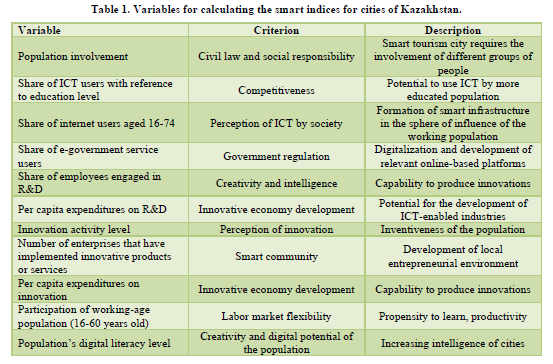
The integrated Smart Tourism City Index (hereinafter denoted as II for simplicity) was calculated using the probability theory formula for the expectation of a discrete random variable as the sum of all the variables by their respective probabilities ki.
The probability coefficients were determined via the method of principal components. In turn, the factor analysis was carried out under the method of chain substitution. The overall factor model was built on the basis of data on 17 cities of the Republic of Kazakhstan. The adequacy of the obtained results was checked by the Kaiser-Meyer-Olkin test.
Since this study aimed to measure the strength of the relationship between the II and GRP, the correlation coefficient was calculated. This practice is widely popular in the international tourism research experience (Pérez León, León Sánchez, Guerrero, 2021; Jelušić, 2017). For the sake of better credibility of the resulting picture, this research considered not the situation for any year but temporal variations. So additional calculation of the II for the period from 2010 to 2019 and tracing how the II will be correlated with GRP in 2010-2020 was conducted. The calculations were performed with the help of Statistica 12.0 software.
The limitation of this study is that it was not possible to access the full range of data that would comprehensively characterize the effectiveness of smart tourism depending on the economic development of a particular city due to their incompleteness and differences in the methodology of primary collection. This particularly refers to the share of tourism employees benefiting from the internet in their work, the number of cultural sites with their own webpage or at least with internet access, and the ability to conduct transactions of purchase and sale of tourist services through the internet. In view of this, the calculations were decided to be limited to the GRP indicator.
RESULTS
As of this date, the states of Central Asia are insufficiently studied in terms of the introduction of modern technology. The novelty and value of this work reside in the fact that the determination of the efficiency of the smart tourism technologies makes allowances for regional characteristics of as many as 17 cities in Kazakhstan. Besides, the calculation process itself was carried out using the formula of mathematical expectation of the probability theory and provided a correlation of the efficiency index with the level of economic development of each region (its GRP level) for the past ten years. This issue remains relevant as the Republic of Kazakhstan is characterized by population growth, annually increasing urbanization, and economic development discrepancies on a city level.
FACTOR ANALYSIS
The purpose of factor analysis was to reduce the variables for calculating II. The components of the factor model were divided into factors A, B, C, D (Table 2) by the method of chain substitution.
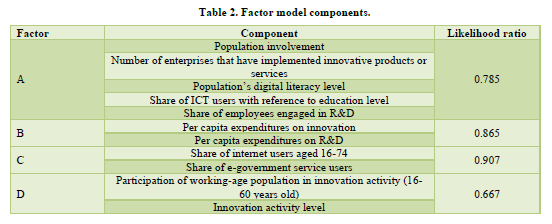
Thuswise, Factor A defines the connection between the population involvement, ICT users (with reference to education level), scientific workers, enterprises promoting ICT, and the level of computer literacy of the population. The variables combined by Factor B are related to expenditures on science and innovation. Factor C combines the variables describing the share of internet users aged 16-74 and the users of e-government services. Finally, Factor D incorporates the variables “Innovation activity level” and “Participation of working-age population in innovation activity (16-60 years old)”. The scheme of the factor model is shown in Figure 1.

Thanks to factor analysis, the number of variables for each city was reduced from 11 to 4. The value of the Kaiser-Meyer-Olkin test for this factor analysis was 0.53 (with a value greater than 0.5, the test is considered valid). Correspondingly, the adequacy of the results obtained was proven.
II calculation under the formula of the mathematical expectation of a discrete random variable
As for the year 2020, the highest II values were found for Almaty-7.7 and Nur-Sultan (Astana)-6.5, followed by Uralsk-4.7, Shymkent-4.5, Atyrau-4.2, Aktobe-4.2, Ust-Kamenogorsk-4.1, Pavlodar-4.1, Karaganda-3.8, Petropavl-3.7, Kostanai-3.5, Aktau-3.4, Kyzylorda and Taraz-3.3, Kokshetau and Turkistan-3.1, and Taldykorgan-2.4 (Figure 2). The obtained distribution allows using the values of the found indices for effective smart tourism city management.

Determination of the II for 2010-2019 was conducted in the same way. With a few exceptions (Shymkent and Aktobe), a steady increase was noted in the II from year to year, especially visible for the most developed Almaty and Nur-Sultan (Astana) (Figure 3).
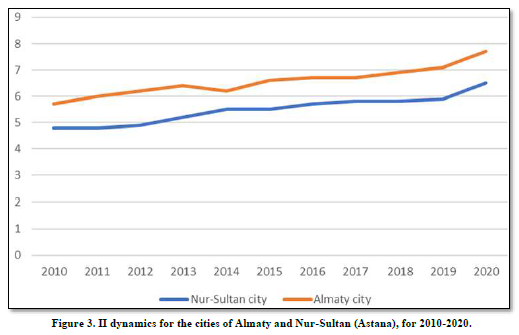
CORRELATION ANALYSIS
According to the Bureau of National Statistics of the Agency for Strategic Planning and Reforms of the Republic of Kazakhstan, the 2020 GRP for the city of Almaty was 13 459 802.6 mln. tenge, for Nur-Sultan (Astana)-7 975 283.1 mln. tenge, for Atyrau-7 738 259.2 mln. tenge, for Karaganda-6 099 856.2 mln. tenge. The lowest GRP indicator was recorded for Kyzylorda-1 645 067.2 mln. tenge, while the other cities occupied intermediate positions between GRP leaders and outsiders. These data were used for correlation analysis.
The calculated correlation coefficients for two data sets-GRP and II estimates (17 cities, time period 2010-2020)-varied from 0.67-0.96, suggesting a moderate (0.5-0.7), high (0.7-0.9), and very high correlation (0.9-1) between II and GRP within the studied cities (according to the Chaddock scale). The highest correlation coefficients were observed for Almaty-0.961. This indicates the closest linear relationship between II and GRP, and therefore between smart technologies for tourism and economic development of the city. Almost equally high values had Nur-Sultan (Astana)-0.958, Kostanai, Karaganda, and Shymkent-0.95, Pavlodar-0.94, and Atyrau and Aktobe-0.92. The next category with high correlation were Ust-Kamenogorsk and Turkestan-0.83, Petropavl-0.82, Taraz-0.81, Aktau-0.81, Kokshetau-0.79, and Uralsk-0.79. The lowest value, 0.68, was characteristic of Kyzylorda city (Table 3). indicating a rather moderate correlation.
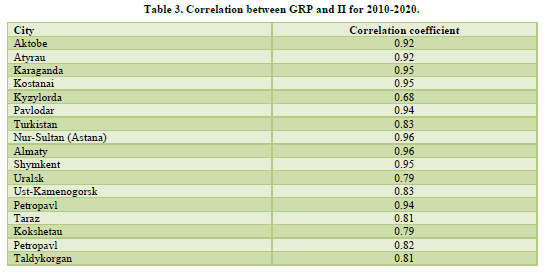
Another indicator of the correlation between GRP and II and can be a scatter diagram. On such diagrams, the relationship is stronger where the points are closer to the conditional regression line. Figure 4 presents a scatter diagram for four cities, the calculated correlation coefficients of which significantly differ from each other: Almaty and Nur-Sultan (very high correlation), Turkistan (high correlation), and Kyzylorda (moderate correlation). With its help, one can trace the slope and width of the relationship between GRP (mln. tenge) and II.
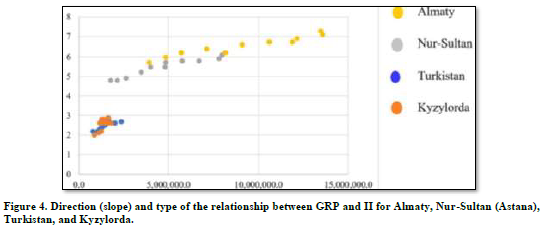
As can be seen from the above, for Almaty, Nur-Sultan (Astana), and Turkistan, a clear positive correlation prevails, whereas Kyzylorda is characterized by a relatively weak but though positive correlation. This is another confirmation that II increases with the rise of GRP. Besides, this method contributes to the expansion of the practical application of correlation analysis. In travel and tourism studies, scatter diagram analysis is applied even without calculations (Pérez León, León Sánchez, Guerrero, 2021). However, in the case of the current examination, they only confirmed the validity of the result obtained.
In sum, Kazakhstan is favorably disposed towards the smart city concept implementation. For example, the city of Almaty has a project of digitalization office, a public reception office Open Almaty, the mobile application Darmen, and other projects under the Smart Almaty strategy. This attitude to the introduction of modern technology is reflected by its leadership in terms of correlation. Nur-Sultan (Astana), in turn, is known for launching a multitasking mobile application “Smart Astana” providing instant information about the weather, traffic, activities, events, and services. Alongside with Nur-Sultan is the city of Akkol, where the Smart Akkol project simplifies payment for utilities and enables environmental monitoring (one can find out the level of air pollution in a particular area) and video surveillance on the roads. In addition, for the safety of tourists and local residents, the Akkol government has installed numerous fire detectors and smart road lighting.
Unfortunately, other cities of Kazakhstan are less developed economically, which is inevitably manifested in the sphere of smart tourism. Not all of them have Wi-Fi access points at the main tourist sites, the employees of the tourist sector do not always possess ICT skills or basic knowledge of a personal computer, and a comparatively small number of them provide services via the internet or have their own regularly updated website. To determine the relationship between the studied factors of the proposed model, a correlation analysis was conducted, which considers the data for all the studied cities of Kazakhstan (Figure 5).
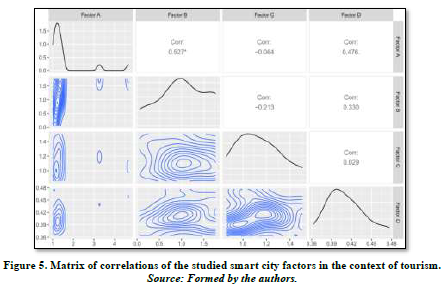
A sufficient correlation between the factors of group A and B is characteristic, although its level does not significantly exceed the average value of the correlation coefficient of 0.5. There is a lack of close correlation between most of the studied groups of factors. This confirms that each group has its own purposefulness and can indicate different facets of a smart city. To determine the most significant groups of factors of a smart city in tourism, the authors conducted modeling based on their relationships with the level of GRP (Table 4).
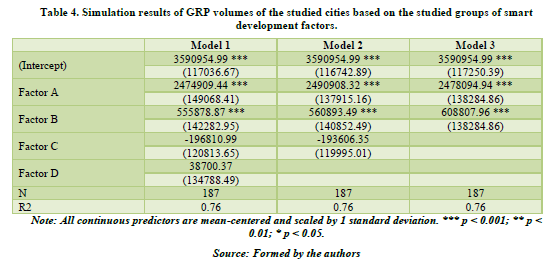
At this stage, the factors of groups C and D are not significant enough for economic efficiency for the studied cities of Kazakhstan in the context of smart economy and tourism. The assessment of the formed models is visualized in Figure 6.
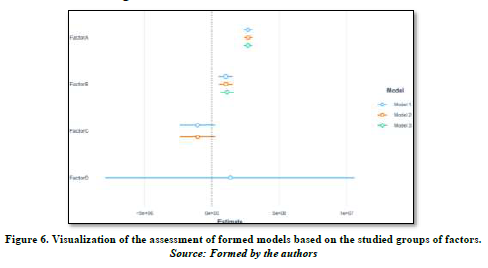
Determination coefficient when excluding insignificant factors remains at the same level (0.76) and demonstrates a fairly high correlation of the studied variables. The determinants of the productive development of smart cities in tourism are the factors of groups A and B. At the same time, such factors as the number of enterprises that have implemented innovative products or services, the level of digital literacy of the population, the share of ICT users depending on the level of education and employees engaged in R&D can have a significant impact on GRP growth and the development of smart cities. GRP growth should be accompanied by an increase in spending on innovation and R&D.
In sum, the present findings confirm the assumption about the direct correlation between the level of economic development of the city and the effectiveness of the use of smart tourism technologies on its territory. Each of the studied cities showed that they are able to introduce new technologies to the degree allowed by their economic development level.
DISCUSSION
The recent practice shows that the efficiency of the use of ICT within the city is directly connected with the effectiveness of the smart tourism technologies it implemented. Hence, for instance, the higher the smart mobility of a particular area, the more effectively it is used in tourism as one of the main components of the economy (Ismagilova, Hughes, Dwivedi, Raman, 2019). The current study continues and complements a number of works [2,9,39] holding the opinion that the concepts of smart city and smart tourism are so closely related that one can even claim about their merging (Chung, Lee, Ham, Koo, 2021). However, what distinguishes this research from others is that it considers regional characteristics which are specific to cities of Kazakhstan and display the local mentality, income level, quality of life, and economic development peculiarities.
In this day and age, academic community representatives emphasize that it is necessary to expand the geography of such studies (Ismagilova, Hughes, Dwivedi, Raman, 2019). They argue that to the works on Spain (Peña, Biscarri, Guerrero, Monedero, & León, 2016). Canada (Boukhechba, Bouzouane, Gaboury, Gouin-Vallerand, Giroux, 2017) the Caribbean region (Pérez León, León Sánchez, Guerrero, 2021) and South Africa (Cilliers, Flowerday, 2017) those considering Asian countries with emerging economies, such as Kazakhstan, should be added.
Some researchers studying the tourism sector rely on the preferences of tourists determined through the analysis of their reviews on social networks (Polese, Botti, Grimaldi, Monda, Vesci, 2018; Abbasi-Moud, Vahdat-Nejad, Mansoor, 2019; Jasrotia, Gangotia, 2018). Though, such a strategy does not seem reliable since not all cities may have high-speed wireless internet and free Wi-Fi access points at tourist sites, as well as not all cultural facilities have a website or sell their services over the internet.
There are also works solving local smart tourism problems, for example, investigating how easy the technology is perceived by the user or how effective it is (Chatterjee, Kar, Gupta, 2018; El-Haddadeh, Weerakkody, Osmani, Thakker, Kapoor, 2019; Goyal, Rathi, Jain, Pilli, Mazumdar, 2018). However, they do not consider the factors that have a direct influence on the adoption of smart technologies-user’s age and education level. The present study, instead, paid increased attention to these aspects.
The current research proposed calculating an integrated index of the effectiveness of the use of the smart city concept for tourism purposes for the 17 cities in the Republic of Kazakhstan. In order to obtain reliable outcomes and simplify the calculation process, four main II factors were formed from a large number of variables using factor analysis. The collected II values showed that the highest rates of smartness within the Republic of Kazakhstan are inherent to Almaty (7.7) and Nur-Sultan (Astana) (6.5), followed by Uralsk, Shymkent, Atyrau, Aktobe, Ust-Kamenogorsk, Pavlodar, Karaganda, Petropavl, Kostanai, Aktau (4.7-3.4), and only then Kyzylorda, Taraz, Kokshetau, Turkistan, Taldykorgan (II less than 3.4). In this manner, one can confidently infer that the core factor determining the effectiveness of smart tourism development in Kazakh cities is the state of their economy.
Researchers worldwide agree that the topic of the economic development of smart cities is quite interesting as each city faces its own set of problems (Kumar, 2020; Akande, Cabral, Casteleyn, 2020; Johnson, Iacob, Välja, van Sinderen, Magnusson, 2014; Keegan, Hare, O Grady, 2012). As regards smart tourism, scientific works usually concentrate upon the share of tourism sector employees using the internet, the share of cultural institutions with internet access, the share of tourist sites selling and buying through the internet, and the share of tourist sites with their own website (Kumar, 2020). We should admit that the current study can be deemed somehow nonstandard in these terms as it has a related limitation residing in the impossibility of considering such factors as relevant data are hardly accessible (even if such databases exist in Kazakhstan). Therefore, it was decided to turn to such an economic indicator as GRP and evaluate the relationship between GRP and II for the last ten years. This approach allowed considering both the relationship strength (according to the Chaddock scale) and direction (according to the scatter diagram). Although it is a common practice to estimate scatter diagrams without calculating correlation coefficients (Pérez León, León Sánchez, Guerrero, 2021). this research provided both to obtain maximally reliable results. As a consequence, it was found that the GRP and II are closely linked-moderate, high, and very high correlation was noted for them. Given the outcomes gained, future researchers can quantitatively assess the relationship between the economic development of the region and smart tourism technologies’ effectiveness, expanding the list of economic indicators for a more comprehensive examination of the issue.
The collected results can be taken advantage of for making right management decisions by the administration of the studied cities. The carried-out analysis enabled conclusions about the development of smart tourism technologies in a city, the strengths and weaknesses in the overall city infrastructure, and future areas of possible improvement. This information can also be used by tourism workers and researchers studying the related domains to solve the whole complex of spatial-temporal problems. The development of a smart tourism city will determine the quality of life not only for tourists but for all city residents.
CONCLUSIONS
This study aimed to quantitatively assess how effective the use of smart tourism technologies is in the cities of Kazakhstan and how it depends on the level of their GRP. For this purpose, a number of indicators were distinguished, which formed four variables of the factor model adopted to calculate the integrated Smart Tourism City Index. The calculations of II were made for 17 cities for the period from 2010 to 2020 using the probability theory formula for the expectation of a discrete random variable. This made it possible to reveal the annually increasing trend for II with the fairly stable positions of Almaty and Nur-Sultan (Astana).
Apart from determining the main smart tourism city indicators and II calculation, the relationship between the index and the economic development of the city was determined. As far as there was no access to data on characteristics possibly more closely related to the tourism sector, as the measure of the city’s economic development level, the GRP indicator was taken. The result of correlation analysis confirmed the presupposition about the presence of a close relationship between these two indicators as a direct correlation between the studied variables was observed for all cities considered. In parallel, a noticeably stronger relationship was noted for more economically developed cities like Nur-Sultan (Astana) and Almaty, whereas, for others, it varied from strong to moderate (according to the Chaddock scale). The scatter diagrams built additionally showed a positive direct correlation between the studied variables, which once more confirmed the adequacy of the collected results. At the same time, it should be noted separately that the conclusions made are relevant specifically for the cities of Kazakhstan and may not be confirmed or confirmed not so unambiguously for countries with more developed economies.
This paper offered a new method of calculating the integrated index of the effectiveness of the use of smart tourism technologies. It considers the socio-cultural and economic characteristics of the capital and the 16 major cities of the Republic of Kazakhstan, traces the relationship between the economic potential of the city and the implementation of the smart tourism city concept, which is of significant practical and scientific value as similar studies are rarely conducted in the field of tourism and travel. The correlation analysis and modeling allowed identifying the most significant groups of factors. The determinants for the effective development of smart cities in tourism are such factors as the number of enterprises introducing innovative products or services, the level of digital literacy of the population, the share of ICT users depending on the level of education and employees engaged in R&D. They can have a significant impact on GRP growth and the development of smart cities. The growth of GRP should contribute to the formation of smart cities, accompanied by an increase in spending on innovation and R&D.
The findings presented may be a useful aid for the city administration striving to make effective management decisions ensuring sustainable development of the administrative-territorial units they stand for. Another important implication is seen in the possibility of expanding and improving the capabilities of smart tourism technologies by IT specialists, in analyzing the current situation on the market and making future forecasts by tourism agents, and in encouraging new research on smart tourism and related areas by world scholars.
The implementation limitation of this study is that the calculation of II for the cities of Kazakhstan cannot be correlated with other analogous calculations from the international practice as this model was developed specifically for the regional characteristics of the largest state of the Central Asian region. Correspondingly, the eleven variables selected by factor analysis will differ completely for other regions. On the other hand, this work extends the practical application of correlation analysis to problems in travel and tourism and shows the suitability and reliability of such methods for dealing with large amounts of data. Future studies can build upon the collected results, use the proposed methodological framework, or develop similar approaches for other variables and economic indicators.
- Ahmed, Z., Nathaniel, S.P., Shahbaz, M. (2021). The criticality of information and communication technology and human capital in environmental sustainability: Evidence from Latin American and Caribbean countries.J Clean Prod, 286.
- Arkorful, V., Barfi, K. A., Aboagye, I. K. (2021). Integration of information and communication technology in teaching: Initial perspectives of senior high school teachers in Ghana. Educ Inf Technol 26, 3771-3787.
- Ahad, M. A., Paiva, S., Tripathi, G., Feroz, N. (2020). Enabling technologies and sustainable smart cities. Sustain Cities Soc 61, 102301.
- Akande, A., Cabral, P., Casteleyn, S. (2020). Understanding the sharing economy and its implication on sustainability in smart cities. J Clean Prod 277, 124077.
- Abbasi-Moud, Z., Vahdat-Nejad, H., Mansoor, W. (2019). Detecting tourists’ preferences by sentiment analysis in smart cities In IEEE Global Conference on Internet of Things (GCIoT) Dubai United Arab Emirates IEEE, pp: 1-4.
- Breetzke, T., Flowerday, S. V (2016). The usability of IVRs for smart city crowdsourcing in developing cities. Electron J Inf Syst Dev Ctries 73, 1-14.
- Biuk-Aghai, R. P., Fong, S., Si, Y. W (2008). Design of a recommender system for mobile tourism multimedia selection. In 2nd International Conference on Internet Multimedia Services Architecture and Applications Bangalore India IEEE, pp: 1-6.
- Buhalis, D. (2019). Technology in tourism-from information communication technologies to eTourism and smart tourism towards ambient intelligence tourism A perspective article. Tour Rev, 75, 267-272.
- Boukhechba, M., Bouzouane, A., Gaboury, S., Gouin-Vallerand, C., Giroux, S. B. et al. (2017). A novel Bluetooth low energy-based system for spatial exploration in smart cities. Expert Syst Appl, 77, 71-82.
- Chung, N., Lee, H., Ham, J., Koo, C. (2021). Smart tourism cities competitiveness index: A conceptual model. In: Information and Communication Technologies in Tourism Cham Springer. pp: 433-438.
- Calderoni, L., Maio, D., Rovis, S (2014). Deploying a network of smart cameras for traffic monitoring on a city kernel. Expert Syst Appl, 41, 502-507.
- Coca-Stefaniak, J.A. (2019). Marketing smart tourism cities a strategic dilemma. Int J Tour Cities, 5, 513-518.
- Cilliers, L., Flowerday, S. (2017). Factors that influence the usability of a participatory IVR crowdsourcing system in a smart city. S Afr Comput J, 29,16-30.
- Chatterjee, S., Kar, A.K., Gupta, M.P. (2018). Success of IoT in smart cities of India an empirical analysis. Gov Inf Q, 35, 349-361.
- Eichelberger, S., Peters, M., Pikkemaat, P., Chan, C.S. (2020). Entrepreneurial ecosystems in smart cities for tourism development: From stakeholder perceptions to regional tourism policy implications. J Hosp Tour Manag, 45, 319-329.
- El-Haddadeh, R., Weerakkody, V., Osmani, M., Thakker, D., Kapoor, K.K. (2019). Examining citizens perceived value of internet of things technologies in facilitating public sector services engagement. Gov Inf Q, 36, 310-320.
- Goffi, G., Cucculelli, M. (2019). Explaining tourism competitiveness in small and medium destinations the Italian case. Curr Issues Tour, 22, 2109-2139.
- Gómez-Vega, M., Picazo-Tadeo, A.J. (2019). Ranking world tourist destinations with a composite indicator of competitiveness To weigh or not to weigh. Tour Manag 72, 281-291.
- Gnambs, T. (2021). The development of gender differences in information and communication technology (ICT) literacy in middle adolescence. Comput Hum Behav, 114, 106533.
- Gandy, O. H Jr, Nemorin, S (2019) Toward a political economy of nudge: smart city variations. Inf Commun Soc, 14, 2112-2126.
- Goyal, T., Rathi, R.,Jain, V.K., Pilli, E.S., Mazumdar, A.P. (2018). Big data handling over Cloud for internet of things. Int J Inf Technol Web Eng, 13, 37-47.
- Habeeb, N.J., Weli, S.T (2020). Relationship of smart cities and smart tourism: An overview. HighTech and Innovation Journal, 1, 194-202.
- Ismagilova, E., Hughes, L., Dwivedi, Y.K., Raman, K.R. (2019). Smart cities Advances in research and information systems perspective. International Journal of Information Management, 47, 88-100.
- International Organization for Standardization (2018). Sustainable cities and communities Indicators for city services and quality of life. Retrieved from: https://www.iso.org/standard/68498.html
- International Organization for Standardization (2019) Sustainable cities and communities Indicators for smart cities. Retrieved from: https://www.iso.org/standard/69050.html
- Irmanti, D., Hidayat, M.R., Amalina, N.V., Suryani, D. (2017). Mobile smart travelling application for Indonesia tourism. Proced Comp Sci, 116, 556-563.
- Jasrotia, A., Gangotia, A. (2018). Smart cities to smart tourism destinations A review paper. J Tour Intellig Smart, 1, 47-56.
- Johnson, P., Iacob, M.E., Välja, M., van Sinderen, M., Magnusson, C. (2014). A method for predicting the probability of business network profitability. Inf Syst e-Bus Manag, 12, 567-593.
- Jelušić, A. (2017). Modelling tourist consumption to achieve economic growth and external balance: Case of Croatia. Tour Hosp Manag, 23, 87-104.
- Keegan, S., O Hare, G.M., O Grady, M.J. (2012). Retail in the digital city. Int J E Bus Res, 8, 18-32.
- Kim, B., Yoo, M., Park, K.C., Lee, K.R., Kim, J.H. (2021). A value of civic voices for smart city: A big data analysis of civic queries posed by Seoul citizens. Cities 108, 102941.
- Kumar, T.V., Dahiya, B. (2017). Smart economy in smart cities. In: Smart economy in smart cities Singapore Springer pp: 3-76.
- Kumar, T.V. (2020). Smart Living for Smart Cities Community Study Ways and Means. Singapore Springer.
- Lai, C.S., Jia, Y., Dong, Z., Wang, D., Tao, Y. (2020). A review of technical standards for smart cities. Clean Technol, 2, 290-310.
- Memon, I., Chen, L.,Majid, A., Lv, M., Hussain, I., et al. (2015). Travel recommendation using geo-tagged photos in social media for tourist. Wirel Pers Commun, 80, 1347-1362.
- Magrini, A., Grassini, L. (2019). The determinants of tourism destination competitiveness in A partial least squares path modelling approach. Stat Appl Italian J Appl Stat, 2, 251-269.
- Pérez León, V.E., León Sánchez, M.A., Guerrero, F.M. (2021). Central American and Caribbean tourism destinations competitiveness A temporal approach. PLoS One, 16.
- Pasquinelli, C., Trunfio, M. (2020) Reframing urban overtourism through the Smart City Lens. Cities, 102, 102729.
- Polese, F., Botti, A., Grimaldi, M., Monda, A., Vesci, M. (2018). Social innovation in smart tourism ecosystems How technology and institutions shape sustainable value co-creation. Sustainability, 10, 140.
- Peña, M., Biscarri, F., Guerrero, J.I., Monedero, I., León, C. (2016). Rule based system to detect energy efficiency anomalies in smart buildings a data mining approach. Expert Syst Appl, 56, 242-255.
- Shamsuddin, S., Srinivasan, S. (2021). Just smart or just and smart cities? Assessing the literature on housing and information and communication technology. Hous Policy Debate, 31, 127-150.
- Shafiee, S., Ghatari, A.R., Hasanzadeh, A., Jahanyan, S. (2019). Developing a model for sustainable smart tourism destinations A systematic review. Tour Manag Perspect, 31, 287-300.
- Tripathy, A.K., Tripathy, P.K., Ray, N.K., Mohanty, S.P. (2018). ITour the future of smart tourism: An IoT framework for the independent mobility of tourists in smart cities, IEEE Consum. Electron Mag, 7, 32-37.
- Wu, X. (2017). Smart tourism based on internet of Things. Rev Fac de Ing, 32, 66-170.
- Zhu, L., Yu, E.R., Wang, Y., Ning B., Tang, T. (2018). Big data analytics in intelligent transportation systems A survey. IEEE Trans Intell Transp Syst, 20, 383-398.







